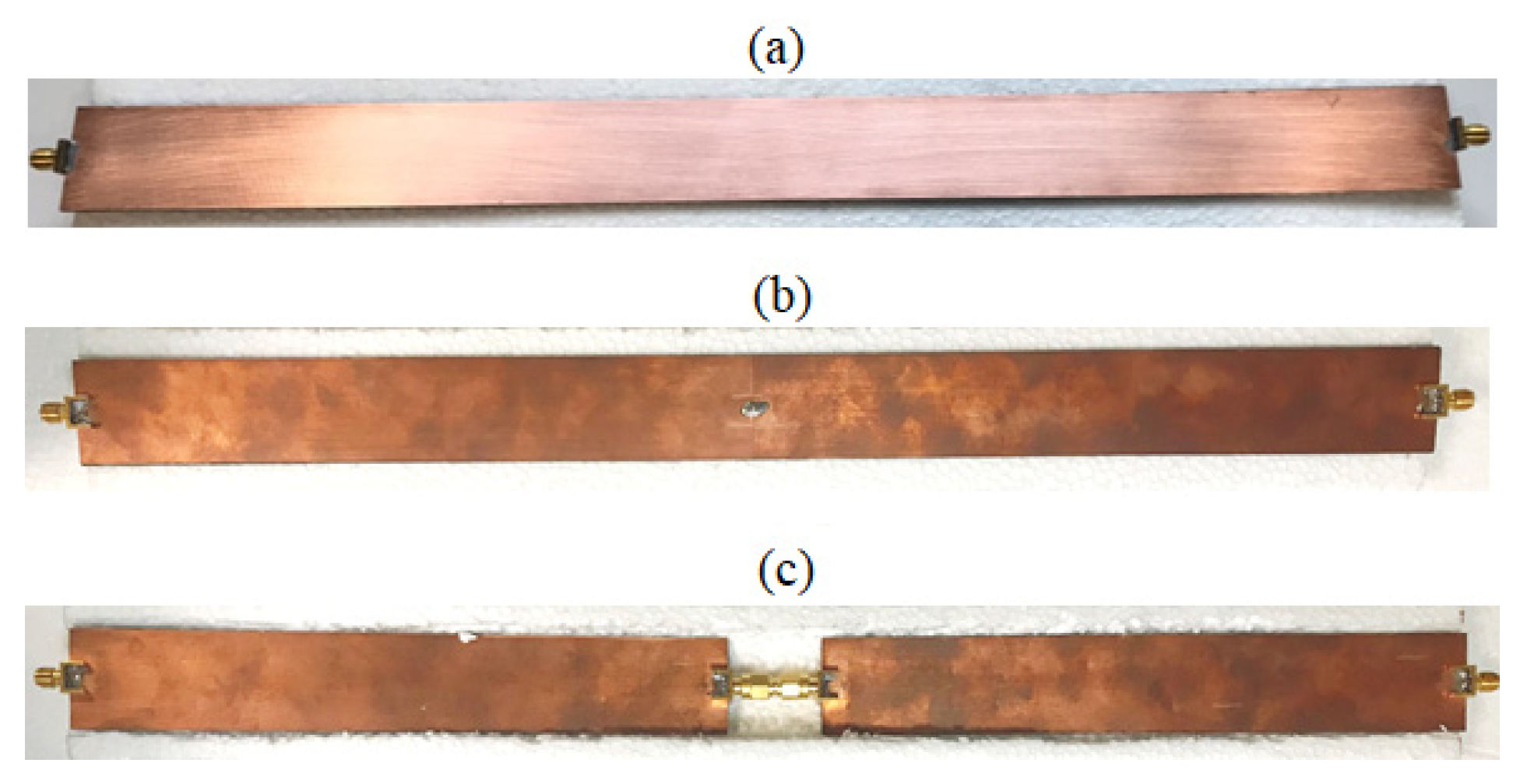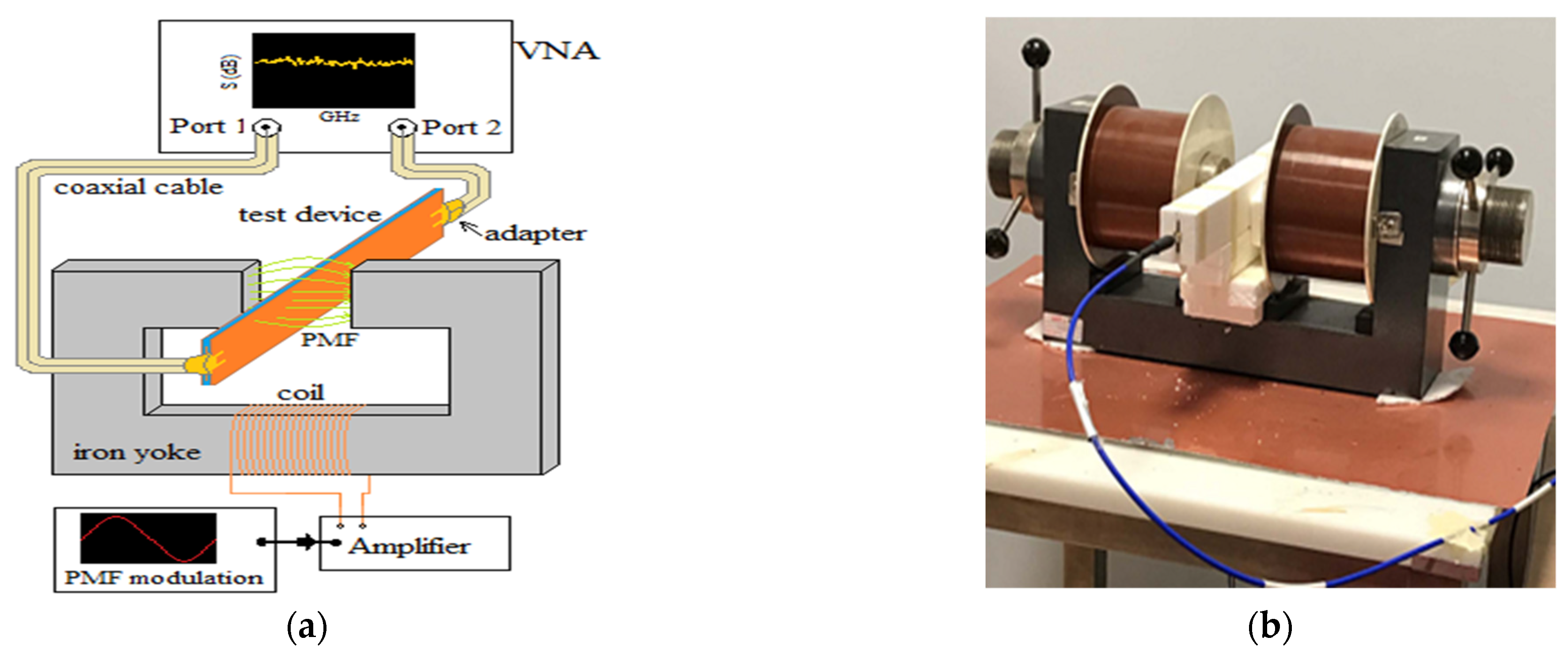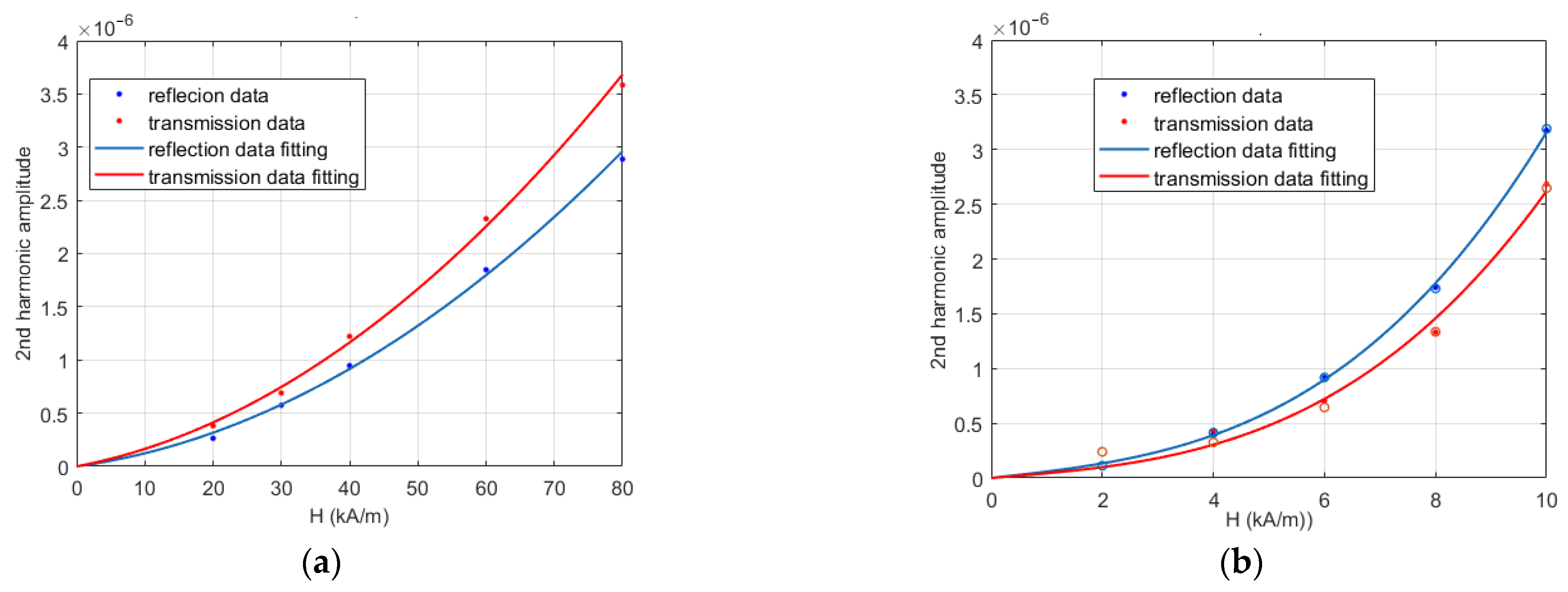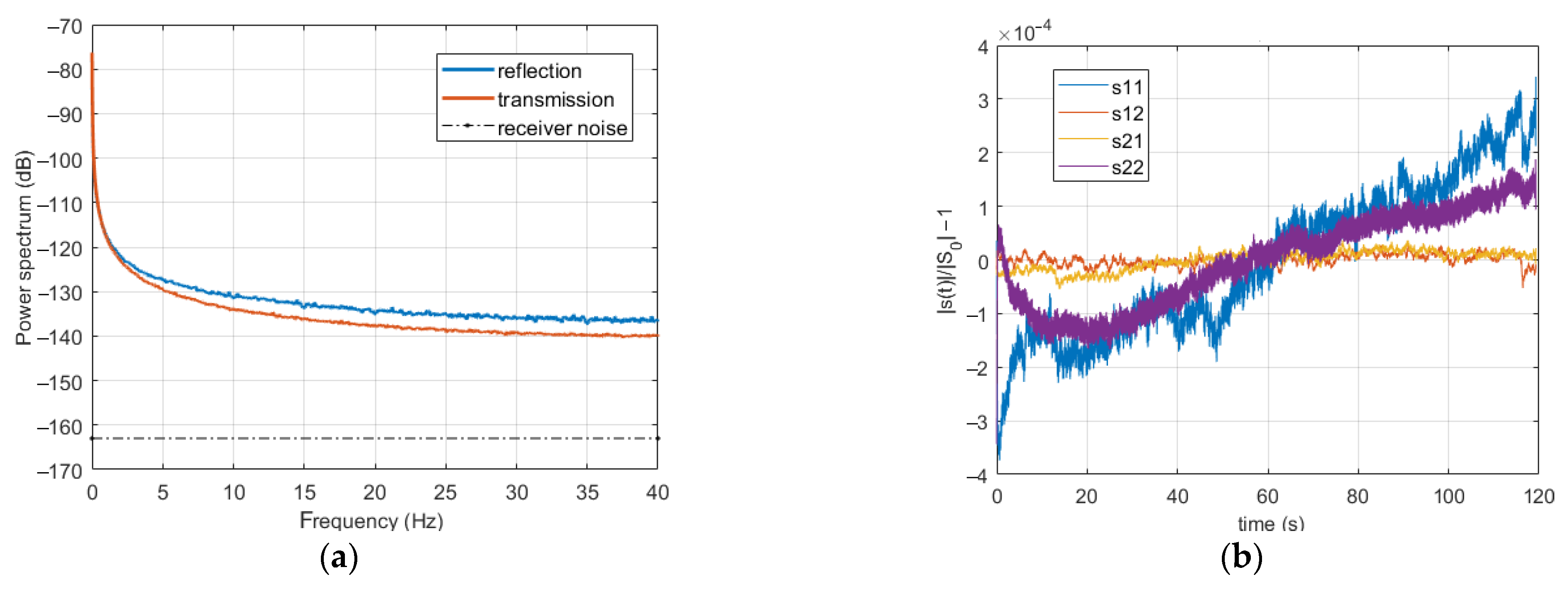Experimental Characterization of Spurious Signals in Magnetic Nanoparticles Enhanced Microwave Imaging of Cancer
Abstract
:1. Introduction
2. Materials and Methods
2.1. Choice of the Test Devices
2.2. Manufactured Test Devices
2.3. Conceptual Scheme of the Test Devices
2.4. Experimental Setup
3. Results and Discussion
3.1. Assessment of the Microwave Response in Absence of Polarizing Magnetic Field
3.2. Assessment of Spurious Magnetic Effects on Strip-1
- As expected, in agreement with (5), all spectra show decreasing noisy amplitudes for ν ≠ nνH (with n natural number), representing the instrumental drift plus noise. Moreover, both drift and noise levels are different for reflection and transmission SPs. Specifically, those of s11 and s22 are about 20 dB lower than those of s21 and s12, which is just the ratio of the amplitudes of reflection and transmission SPs (see Table 1). This result is again in good agreement with (5)–(7), according to which both the drift and the generator noise are multiplied by the s0 of the corresponding SP. The receiver noise, which is independent of s0 and has a spectral level of about −163 dB, is masked by the generator noise.
- Figure 6a also shows that the drift, being slowly variable in time, has a spectrum confined to low frequencies. As already stressed in [11,16], this implies that the choice of the PMF modulation frequency, νH, plays a crucial role in counteracting the effect of the instrumental drift. Of course, such choice depends on the employed measurement instrumentation, but also on the MW system being considered and on the amplitudes of the SPs being the drift multiplied by s0. This point will be discussed in Section 5.
- All the spectra exhibit a 1st order harmonic at the PMF modulation frequency νH = 5 Hz, while no higher order harmonics, i.e., at ν = nνH, n > 1, are observed (at least above the drift and noise levels). As previously noted, a possible cause of such harmonic components could be the modulation of the currents flowing in the conductors of the strip, due to the force exerted on the charge carriers by the PMF. This force translates into an anisotropic modulation of the conductivity that, at the main order, is proportional to the applied PMF. However, this hypothesis is not consistent with the significant difference observed in Figure 6a among the amplitudes of the harmonics of the four SPs. Indeed, while a difference is possible between reflection and transmission SPs, this cannot happen between s12 and s21, or between s11 and s22, due to the symmetry of the experimental setup, which makes an exchange between ports 1 and 2 equivalent to a rotation of 180 degrees of the full device. This suggests that the observed first harmonic is not ascribable to the PMF modulation of the conduction currents, or, more generally, to an effect of the PMF on the TD, but more likely to an influence of the PMF on the VNA. To check this hypothesis, we performed an additional measurement in the same PMF conditions, but disconnected the TD from the VNA and left the ports of the VNA floating. The results are shown in Figure 6b, where only the spectra of s11 and s22 are reported. As can be seen, a first harmonic is still present, and its amplitude is even larger than the one measured in the presence of strip-1. Such a result makes us confidently conclude that the observed first harmonics is prevalently an effect of the fringing PMF on the VNA (possibly on its inner electronics).
3.3. Assessment of Spurious Magnetic Effects on Strip-2 and Strip-3
- For both strip-2 and strip-3, a first order harmonic component is present in all the spectra. In strip-2, the amplitudes of such harmonics are comparable to those observed for strip-1, and exhibit the same behavior, i.e., they are different for the four SPs. On the other side, in the case of strip-3, these harmonics have quite the same amplitude for all the SPs, which is larger than that observed for strip-1 and strip-2, despite the applied PMF being 8 times lower. These observations suggest that the central welding in strip-2 does not significantly respond to the applied PMF, so that the first harmonic is still essentially due to an effect of the PMF on the VNA. Conversely, in the case of strip-3, the first harmonic (much larger, if referred to the same PMF amplitude) appears to be prevalently due to the central through.
- A second order harmonic is also present, with an amplitude of about −110 dB for all the SPs in both cases. According to the results in Section 3.2, this harmonic contribution cannot be ascribed to the strip-line or to the VNA, but to the central loads, since strip-2 and strip-3 differ from strip-1 only for the central load, wherein magnetic materials are likely to be present. While this was expected for the through and the connectors, it is somewhat surprising for the welding. Either way, the second harmonic generated by the welding is much lower, confirming that the connectors are the components that, more than any others, should be kept away from the PMF to prevent spurious magnetic effects.
- For strip-3, one can also observe a third order harmonic not present in the SPs of strip-2. Again, such a harmonic exhibits the same amplitude of about −122 dB for all four SPs. A possible explanation of this outcome is reported in the Appendix A.
3.4. Assessment of the Instrumental Drift
4. Design Guidelines
Application to the MNPs-Enhanced MW Detection of Cancer
5. Conclusions
Author Contributions
Funding
Institutional Review Board Statement
Informed Consent Statement
Conflicts of Interest
Abbreviations
| MNP | Magnetic Nanoparticle |
| MWI | MicroWave Imgning |
| PMF | Polarizing Magnetic Field |
| TD | Test device |
| SP | Scattering parameter |
| VNA | Vector Network Analyzer |
Appendix A

References
- Nikolova, N.K. Microwave imaging for breast cancer. IEEE Microw. Mag. 2011, 12, 78–94. [Google Scholar] [CrossRef]
- Bellizzi, G.; Bucci, O.M.; Catapano, I. Microwave cancer imaging exploiting magnetic nanoparticles as contrast agent. IEEE Trans. Biomed. Eng. 2011, 58, 2528–2536. [Google Scholar] [CrossRef] [PubMed]
- Kalmykov, Y.P.; Coffey, W.T. Transverse complex magnetic susceptibility of single-domain ferromagnetic particles with uniaxial anisotropy subjected to a longitudinal uniform magnetic field. Phys. Rev. B Condens. Matter 1997, 56, 3325–3337. [Google Scholar] [CrossRef]
- Bucci, O.M.; Bellizzi, G.; Bellizzi, G.G. Microwave broadband characterization of a diluted water-based ferrofluid in presence of a polarizing magnetic field. IEEE Trans. Magn. 2017, 53, 5300108. [Google Scholar] [CrossRef]
- Lazebnik, M.; Popovic, D.; McCartney, L.; Watkins, C.B.; Lindstrom, M.J.; Harter, J.; Sewall, S.; Ogilvie, T.; Magliocco, A.; Breslin, T.M.; et al. A large-scale study of the ultrawideband microwave dielectric properties of normal, benign and malignant breast tissues obtained from cancer surgeries. Phys. Med. Biol. 2007, 52, 6093–6115. [Google Scholar] [CrossRef] [PubMed]
- Sugitani, T.; Kubota, S.; Kuroki, S.; Sogo, K.; Arihiro, K.; Okada, M.; Kadoya, T.; Hide, M.; Oda, M.; Kikkawa, T. Complex permittivities of breast tumor tissues obtained from cancer surgeries. Appl. Phys. Lett. 2014, 104, 253702-1–253702-5. [Google Scholar] [CrossRef]
- Bucci, O.M.; Bellizzi, G.; Catapano, I.; Crocco, L.; Scapaticci, R. MNP enhanced microwave breast cancer imaging: Measurement constraints and achievable performances. IEEE Antennas Wirel. Propag. Lett. 2012, 11, 1630–1633. [Google Scholar] [CrossRef]
- Scapaticci, R.; Bellizzi, G.; Catapano, I.; Crocco, L.; Bucci, O.M. An effective procedure for MNP-enhanced breast cancer microwave imaging. IEEE Trans. Biomed. Eng. 2014, 61, 1071–1079. [Google Scholar] [CrossRef] [PubMed] [Green Version]
- Ley, S.; Helbig, M.; Sachs, J. Preliminary investigations of magnetic modulated nanoparticles for microwave breast cancer detection. Curr. Dir. Biomed Eng. 2015, 1, 302–305. [Google Scholar] [CrossRef]
- Bucci, O.M.; Bellizzi, G.; Borgia, A.; Costanzo, S.; Crocco, L.; Di Massa, G.; Scapaticci, R. Experimental framework for magnetic nanoparticles enhanced breast cancer microwave imaging. IEEE Access 2017, 5, 16332–16340. [Google Scholar] [CrossRef]
- Bucci, O.M.; Bellizzi, G.; Costanzo, S.; Crocco, L.; Di Massa, G.; Scapaticci, R. Assessing detection limits in magnetic nanoparticle enhanced microwave imaging. IEEE Access 2018, 6, 16332–16340. [Google Scholar] [CrossRef]
- Kaye, C.; Gilmore, C.; Lo Vetri, J. Enhanced detection of magnetic nanoparticles using a novel microwave ferromagnetic resonance imaging system. IEEE Trans. Biomed. Eng. 2020, 68, 936–947. [Google Scholar] [CrossRef] [PubMed]
- Skandalakis, G.P.; Rivera, D.R.; Rizea, C.D.; Bouras, A.; Raj, J.G.J.; Bozec, D.; Hadjipanayis, C.G. Hyperthermia treatment advances for brain tumors. Int. J. Hyperth. 2020, 37, 3–19. [Google Scholar] [CrossRef] [PubMed]
- Wilhelm, S.; Tavares, A.J.; Dai, Q.; Ohta, S.; Audet, J.; Dvorak, H.F.; Chan, W.C.W. Analysis of nanoparticle delivery to tumours. Nat. Rev. Mater. 2016, 1, 1–12. [Google Scholar] [CrossRef]
- Van Bladel, J.G. Electromagnetic Fields, 2nd ed.; Wiley-IEEE Press: Piscataway, NJ, USA, 2007. [Google Scholar]
- Bucci, O.M.; Bellizzi, G.; Costanzo, S.; Crocco, L.; Di Massa, G.; Scapaticci, R. Preliminary Assessment of the Origin of Spurious Magnetic Effects in Magnetic Nanoparticle Enhanced Microwave Imaging. In Proceedings of the 13th European Conference on Antennas Propagation (EUCAP), Krakow, Poland, 31 March–5 April 2019. [Google Scholar]
- Bellizzi, G.; Bucci, O.M. Magnetic nanoparticle-guided blind focusing in microwave hyperthermia of neck tumors. IEEE Access 2019, 7, 64063–64076. [Google Scholar] [CrossRef]









| TD | |s11| | |s22| | |s12| [|s21|] | leq [mm] | εeq |
|---|---|---|---|---|---|
| strip-1 | 0.071 ± 0.025 | 0.067 ± 0.024 | 0.928 ± 0.090 | 584 | 2.03 |
| strip-2 | 0.119 ± 0.051 | 0.114 ± 0.067 | 0.906 ± 0.027 | 588 | 2.06 |
| strip-3 | 0.076 ± 0.035 | 0.072 ± 0.029 | 0.918 ± 0.009 | 641 | 2.12 |
Publisher’s Note: MDPI stays neutral with regard to jurisdictional claims in published maps and institutional affiliations. |
© 2021 by the authors. Licensee MDPI, Basel, Switzerland. This article is an open access article distributed under the terms and conditions of the Creative Commons Attribution (CC BY) license (https://creativecommons.org/licenses/by/4.0/).
Share and Cite
Bucci, O.M.; Bellizzi, G.; Costanzo, S.; Crocco, L.; Di Massa, G.; Scapaticci, R. Experimental Characterization of Spurious Signals in Magnetic Nanoparticles Enhanced Microwave Imaging of Cancer. Sensors 2021, 21, 2820. https://doi.org/10.3390/s21082820
Bucci OM, Bellizzi G, Costanzo S, Crocco L, Di Massa G, Scapaticci R. Experimental Characterization of Spurious Signals in Magnetic Nanoparticles Enhanced Microwave Imaging of Cancer. Sensors. 2021; 21(8):2820. https://doi.org/10.3390/s21082820
Chicago/Turabian StyleBucci, Ovidio M., Gennaro Bellizzi, Sandra Costanzo, Lorenzo Crocco, Giuseppe Di Massa, and Rosa Scapaticci. 2021. "Experimental Characterization of Spurious Signals in Magnetic Nanoparticles Enhanced Microwave Imaging of Cancer" Sensors 21, no. 8: 2820. https://doi.org/10.3390/s21082820
APA StyleBucci, O. M., Bellizzi, G., Costanzo, S., Crocco, L., Di Massa, G., & Scapaticci, R. (2021). Experimental Characterization of Spurious Signals in Magnetic Nanoparticles Enhanced Microwave Imaging of Cancer. Sensors, 21(8), 2820. https://doi.org/10.3390/s21082820








